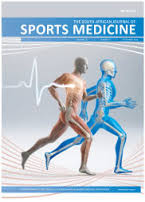Strategies used by professional rugby union clubs to manage players for artificial turf exposure
DOI:
https://doi.org/10.17159/2078-516X/2020/v32i1a8276Abstract
Background: The use of artificial turf on rugby pitches is increasingly commonplace but there is limited evidence around its effects on injury, recovery, and performance. It is unclear whether this uncertainty influences player management strategies in professional clubs.
Objectives: To understand how professional rugby union clubs in England approach player management for artificial turf, to explore how the beliefs of medical and strength/conditioning staff influence these decisions, and to determine whether differences exist between clubs with different levels of exposure to artificial surfaces.
Methods: The study was a cross-sectional mixed methods study. Twenty-three medical and strength/conditioning staff members from 12 English Premiership Rugby Union clubs completed two bespoke questionnaires and participated in a semi-structured interview.
Results: Two-thirds of the participants described formal club-level approaches to artificial turf. All participants from low- exposure clubs (<50% training and match time on artificial pitches) reported adjusting player recovery strategies following games on artificial turf to mitigate elevated muscle soreness and fatigue. Clubs with artificial surfaces at their home venues were less likely to adapt recovery than clubs with natural turf pitches. Regardless of exposure participants believed switching between surface types was a risk factor for injury. Medics reported that acute injuries associated with artificial turf exposure typically occurred at the foot or ankle, whereas abrasions and overuse injuries were more common and often affected the knees, hips and lower back. Players with compromised joints were less likely to be selected for matches on artificial surfaces.
Conclusion: Player management around artificial turf is a focus for staff at professional rugby union clubs. Club practices vary by exposure and may consequently influence injury risk estimates.
Downloads
Downloads
Published
Issue
Section
License
Copyright (c) 2020 South African Journal of Sports Medicine

This work is licensed under a Creative Commons Attribution 4.0 International License.
The South African Journal of Sports Medicine reserves copyright of the material published. The work is licensed under a Creative Commons Attribution 4.0 (CC BY 4.0) International License. Material submitted for publication in the South African Journal of Sports Medicine is accepted provided it has not been published elsewhere. The South African Journal of Sports Medicine does not hold itself responsible for statements made by the authors.
How to Cite
- Abstract 758
- PDF 607
- PDF (Supplementary) 56
- PDF (Supplementary) 59
Metrics

- Citations
- Citation Indexes: 2
- Usage
- Full Text Views: 154
- Abstract Views: 19
- Captures
- Readers: 16





.png)